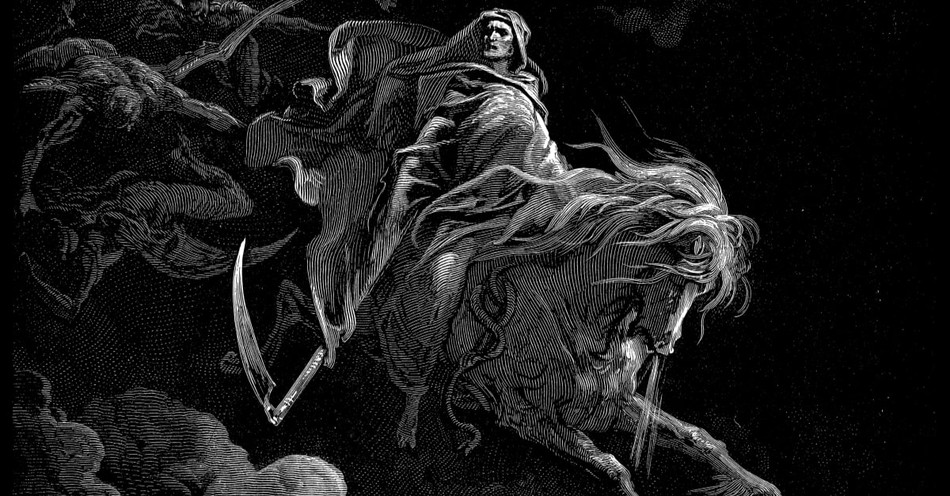Revelation, also known as the Apocalypse, is the New Testament’s final book and provides fantastic imagery and prophecies. One disturbing image appears when John says, “Behold a pale horse.”
Throughout the Bible, prophetic books use symbols to communicate deeper messages. Many images in Revelation had special meaning for the people John wrote to—but also ideas that matter to believers today. How can we explore what it means when Revelation says “Behold a pale horse,” and apply that meaning to our lives today?
Where Does the Bible Say “Behold a Pale Horse”?
Revelation 6:8 states, “I looked, and behold a pale horse! Its rider’s name was Death, and Hades followed him. They were given authority over a fourth of the earth, to kill with sword and with famine and with pestilence and by wild beasts of the earth.”
John wrote Revelation from visions he received through Jesus Christ while exiled on Patmos. These visions encouraged and strengthened the believer’s faith as he and other early Christians faced persecution under Rome. The visions also described good’s ultimate triumph over evil and the establishment of God’s kingdom—which many scholars argue means that the book takes a larger view, going beyond John’s time to show the final judgment and God creating the new heaven and earth.
Revelation begins with letters to the seven churches in Asia Minor, each addressing specific issues within those congregations and calling for repentance and perseverance. These letters set the stage for more dramatic later visions, emphasizing faithfulness matters and that overcomers will be rewarded.
Before the pale horse appears, the Lamb (representing Jesus Christ) opens seven seals on a scroll. Each seal’s opening reveals a different aspect of the apocalyptic vision.
- The first seal releases a white horse.
- The second seal unleashes a red horse.
- The third seal reveals a black horse with its rider holding scales.
- The fourth seal introduces the pale horse and its rider, Death, accompanied by Hades.
After the pale horse, the fifth seal reveals the souls of martyrs beneath an altar, crying for justice and retribution. They are given white robes and told to rest until the number of their fellow servants and brothers, who were to be killed as they were, is completed. The scene aligns with divine justice, vindicating those who have suffered for their faith.
The sixth seal’s opening brings cosmic disturbances: a great earthquake, the sun turning black, the moon becoming like blood, and stars falling from the sky. These dramatic events signal the imminent arrival of God’s judgment. The chapter ends by depicting people from all nations, from kings to slaves, hiding in caves and among the rocks, fearing the Lamb’s wrath.
How Is the Pale Horse Related to the Other Three Horses of the Apocalypse?
The pale horse represents death and brings massive devastation, using various means to achieve its grim purpose. This includes war, famine, disease, and wild animal attacks. The pale horse intensifies the chaos and suffering the previous three horses unleashed. Therefore, we must consider what each horse communicates.
The first horse is white, and its rider carries a bow and is given a crown (Revelation 6:2). This rider goes out “conquering and to conquer.” The white horse and its rider symbolize conquest and victory—symbols people living under Roman imperial oppression would recognize. The rider initiates events leading to the end times through subjugation and domination.
The second horse, a fiery red one, explains that its rider is granted the power to take peace from the earth and to make people kill each other (Revelation 6:4). The rider wields a large sword, symbolizing war and bloodshed. The red horse brings conflict and violence, disrupting the peace and stability of societies and leading to widespread strife and destruction.
The black horse has a rider holding a pair of scales (Revelation 6:5-6), indicating economic imbalance and poverty. A voice among the four living creatures says, “A quart of wheat for a denarius, and three quarts of barley for a denarius, and do not harm the oil and wine!” This horse and rider represents economic hardship. The scales suggest that food will become scarce and expensive, leading to starvation and suffering for many.
Finally, the horse’s pale color reflects the pallor of death. The rider’s mission encompasses various deadly forces: the sword (war), famine, pestilence (disease), and wild beasts. This rider has authority over a quarter of the earth, signaling a wide impact on humanity.
The four horsemen collectively set the stage for the severe trials and judgments described throughout the rest of Revelation. They symbolize the forces sent to devastate the earth and its people as part of the divine plan to bring about the current age’s end and establish God’s kingdom.
What Might the Pale Horse in Revelation Represent?
In traditional Christian doctrine, the pale horse symbolizes death and the aftermath based on human sinfulness and divine judgment. The color, often described as a sickly green or ashen hue, evokes decay and disease. The rider, named Death, followed by Hades (the abode of the dead), suggests the horseman brings about widespread mortality. The horsemen collectively depict the apocalyptic events preceding the end times’ final destructive events. Here, the pale horse reinforces the theme of divine retribution for human transgressions.
While scholars typically agree that the pale horse symbolizes death, what kind of death is debated. There are four typical views on Revelation.
From a historical-critical perspective, the pale horse may represent epidemics or plagues that have devastated humanity throughout history. Scholars argue John drew upon contemporary events and fears to convey his prophetic vision. In this context, the pale horse could allude to diseases that afflicted ancient societies. This interpretation underscores how John used symbolic language in Revelation to address crises and anxieties faced by early Christians.
Literary scholars explore Revelation’s symbolic and thematic elements. In this view, the pale horse represents more than just physical death; it embodies the existential dread and the ultimate fate awaiting sinful humanity. The progression from the white horse (conquest) to the red horse (war) to the black horse (famine) and finally to the pale horse (death) illustrates an escalating cycle of human suffering and divine judgment. This literary approach highlights how the vivid imagery evokes emotional responses from readers.
In futurist eschatology, which views Revelation as providing vivid and symbolic language to describe events leading up to the world’s end, the pale horse is seen as a literal prophetic figure who will manifest during the end times. Proponents of this view believe the pale horse’s arrival will coincide with actual global pandemics and widespread death as part of the tribulations leading up to Christ’s second coming. The second coming includes the world’s end (or resurrection in some interpretations), the final judgment, and God creating the new heaven and earth.
The preterist perspective interprets Revelation as describing events that have already occurred and sees the pale horse as representing the first century’s catastrophic events, particularly those related to Jerusalem’s fall and the subsequent turmoil in the Roman Empire. According to this view, the pale horse symbolizes the widespread death and destruction that followed the Jewish-Roman wars, reflecting the immediate historical context in which Revelation was written.
The pale horse in Revelation encompasses many interpretations, each offering valuable insights into its symbolic meaning. These diverse perspectives enrich our understanding of Revelation and its enduring impact on Christian thought and theology.
What Can We Learn from the “Behold a Pale Horse” Passage Today?
No matter which theological perspective you adhere to, we can learn several crucial lessons from Revelation’s pale horse, revealing important principles and truths to apply.
First, the pale horse teaches about human life’s transience. In a world where many live like they have endless time, the pale horse’s arrival reminds us life is fragile and unpredictable. Therefore, we live with a sense of urgency and purpose, prioritizing our spiritual growth and relationship with God over temporary worldly pursuits. An eternal perspective inspires us to make the most of our time here on earth, focusing on what truly matters—loving God and serving others.
Second, the pale horse symbolizes sin’s consequences, leading to death and judgment. In Romans 6:23, the Apostle Paul writes, “For the wages of sin is death, but the gift of God is eternal life in Christ Jesus our Lord.” Sin leads to spiritual death and separation from God. The pale horse serves as a warning to avoid sinful behaviors and to seek repentance and forgiveness through Christ. Understanding this can motivate us to live righteously and share salvation’s message with others.
Third, the pale horse’s depiction of widespread death and destruction reminds us of diseases that have affected humanity throughout history and even today. As many in the early church did, we can respond to such crises with compassion and faith, trusting God’s sovereignty and care. The pale horse’s presence in Revelation encourages us to support those who are suffering, pray for healing and protection, and rely on God’s promises during challenging times.
Third, the pale horse points to the ultimate hope found in Jesus Christ. In John 14:6, Jesus declares, “I am the way, the truth, and the life. No one comes to the Father except through me.” We don’t have to settle for sin and death. Salvation and eternal life are only possible through a relationship with Christ. The pale horse’s reminder of death and judgment reveals the necessity to repent unto Jesus for redemption and life. We must prioritize our faith in Christ, seek to know him more deeply and follow his teachings.
Finally, the pale horse serves as a call to worship God alone. In Revelation, the apocalyptic events are not just about doom but also about God’s ultimate victory and establishing his kingdom. We must remain steadfast in our faith, praising God and trusting in his plan. The pale horse reminds us that God is in control despite the world’s trials and tribulations, and his purposes will prevail.
By heeding these lessons, we live with a sense of urgency, purpose, and hope, trusting in Jesus as our Savior and striving to follow his will.
Photo Credit: Public domain (illustration by Gustave Doré, via Wikimedia Commons)

This article is part of our larger End Times Resource Library. Learn more about the rapture, the anti-christ, bible prophecy and the tribulation with articles that explain Biblical truths. You do not need to fear or worry about the future!
The Second Coming of Jesus
Who Are the 144,000 in Revelation?
Who Are Gog and Magog in the Bible?
What Is the Apollyon?
Is the Apocalypse Mentioned in the Bible?
Signs of the End Times and the Rapture



.jpg)
